Sorted by date Results 1 - 25 of 78

That raucous chatter heard often in neighborhoods across Oregon is what I refer to as the Western Blue-Jay [Aphelocoma californica]. Originally referred to as a "scrub" jay, they now have a larger population within forests and towns. This blue-with-a-gray-back jay inhabits residential areas in large numbers, gleaning food from backyard feeders and trees. Insects, nuts, snails, berries, and bees make up their main diet. A six-inch nest is built within tree branches, where two... Full story

Northern Goshawks are found throughout the mountains and forests of North America and Eurasia. In North America they range from western central Alaska and the Yukon territories in the north to the mountains of northwestern and western Mexico. They are typically not found in the southeastern United States. Northern Goshawks can be found in coniferous and deciduous forests. During their nesting period, they prefer mature forests consisting of a combination of old, tall trees wit... Full story

Ruby-crowned Kinglets (Regulus calendula) were first described in 1766 by Linnaeus, and its generic name is latin for little king. They are very common now, flitting and hanging in the air gleaning small insects from trees and bushes. They live in mixed woods, isolated trees in meadows, coniferous and deciduous forests, mountain-shrub habitat, and floodplain forests of oak, pine, spruce, or aspen. These tiny birds nest high in trees, and so prefer older, taller, and denser... Full story

Quickly moving rivers and streams are home to the Common Merganser (Mergus merganser). Cruising jet-like up and down waterways, only a few inches above the ripples, landing and then diving for fish and crustaceans with their serrated bills, this Merganser sports either a vivid rust coloured crest (female) or an iridescent green head (male) that is a joy to behold. The Common Merganser nests in hollowed-out trees, on cliffs or on the ground, normally on the banks of rivers.... Full story

While perched on the tip of a branch the Ash-throated Flycatcher [Myiarchus cinerascens] will tweak its head from side to side in a quizzical manner as it waits for its next insect meal. They prefer drier environs and do not drink water because all is needed are the fluids from their insect diet. Small lizards, fruits, and berries are occasionally consumed. Three to seven brown- streaked white eggs are laid after a nest of grasses, twigs, and rootlets are woven together and... Full story
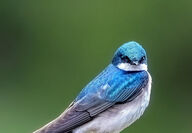
The Tree Swallow [Tachycineta bicolor] is about five inches long and has a forked tail, sparkling metallic green to blue head, and white feathers on its underside. Females are duller in color than males. In North America, Tree Swallows breed from Alaska east to Newfoundland, Canada and south to California, Colorado, Nebraska, and Maryland. It winters north to southern California, the Gulf Coast, and the Carolinas. They nest in aged trees occasionally using old woodpecker... Full story
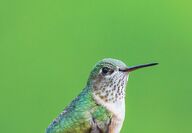
As the smallest bird in North America, and the smallest long distance migrating bird in the world, the Calliope Hummingbird's [Selasphorus calliope] migration of 5,000 miles from southern Mexico to western mountainous regions is prodigious and inspiring. When heading north the Calliope flies along the Pacific coast and returns south along the Rocky Mountains for a round trip total of 10,000 miles. This tiny hummer weighs in at 0.1 ounce which is similar to a ping-pong ball.... Full story
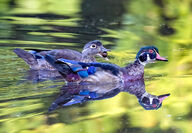
The most colorful of all our ducks, the Wood Duck [Aix sponsa], lives and breeds in swampy forested areas. Acorns are a favorite food along with other seeds, salamanders, aquatic insects, snails, and tadpoles. Courtship begins in fall and may be interrupted by harsh weather, and then be resumed in spring. They nest primarily in tree cavities and man-made nesting boxes. Females line the nest with breast feathers and will lay between nine and 14 eggs. After approximately 35... Full story

Wading along rivers, streams, and lakes is America's largest heron, the Great Blue - possessing a wingspan of up to 79 inches and a height of 40 to 53 inches. Around Sisters, they can often be seen in wheat and grass fields feeding on moles, gophers, frogs, insects and ground squirrels. Also Great Blues can be seen overhead soaring slowly, traveling to their nests or new feeding areas, such as your backyard pond. They will form rookeries in mature forests in which large stick... Full story
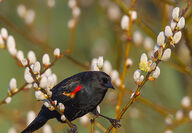
The Red-winged Blackbird [Agelaius phoeniceus], is now arriving around Sisters and feeding until they head to mostly wetland areas to begin building nests. After two to six pale blue-green eggs are laid the young hatch in only 10 to 12 days. The young, being fed on insects and seeds, leave the nest in 11 to 14 days. Two to three clutches may be laid every year. The Red-wing can be very protective of their nesting areas and will attack hawks and crows from above, diving with... Full story

Visiting the Cascade forests in late fall and winter, the fluted notes of the Varied Thrush [zoreus naevius] can often be heard echoing through the forests and canyons. The elegant orange of the Varied Thrush can be seen throughout winter and are definitely a western bird. Their breeding range extends as far north as Alaska and western Canada to the forests of Oregon and Washington. They winter down the coast of California coast to Baja. The varied Thrush was first identified... Full story
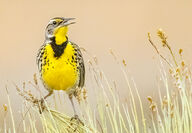
The Western Meadowlark [Sturnella negleckta] with its bright yellow breast is found in many varied habitats, from high desert sage, grasslands, and wetlands, to the shoulders of Mt. Jefferson. Its flute-like songs can be heard throughout the day. Nests are built on the ground and covered with a roof of grass and contain five to six white eggs with rust and lavender spots, which are incubated for 13-16 days. The chicks are in the nest for 10-12 days before fledging. A male... Full story
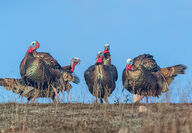
The wild turkey [Meleagris Gallopavo] is not a native species in Oregon. Introduced in 1961 by ODFW, they are now well-established in the pine forests around the Metolius Basin. The subspecies Rio Grande has had the most successful natural expansion, although the Merriam's also has a steady population. Females lay 10-14 beige mottled eggs which hatch in approximately 28 days, and within 24 hours of hatching the poults have left the nest. Insects, berries, seeds, and all... Full story
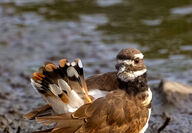
The Killdeer [Charadrius vociferus], is the largest of the ringed plovers, and the only plover with a double breast band. In flight, the Killdeer's long, pointed, slender wings have conspicuous white wing stripes. Killdeer frequent a variety of open habitats such as fields, meadows, gravel bars, and mudflats throughout the United States and most of Canada. Their diet includes snails, grasshoppers, worms, beetles, and other invertebrates. They can often be seen in fall in... Full story

The Cooper's Hawk [Accipiter cooperii], was named after naturalist William Cooper of the New York Museum, and inhabits woodland areas, where their diet consists of birds (95 percent) and small mammals (25 percent). This of course varies depending on the season and area hunted. These mid-sized hawks at maturity are 14-17 inches tall and weigh 16-24 ounces. The females are 1/3 larger than the males. They are referred to as "chicken hawks" "blue darter," or "swift hawk"," and... Full story
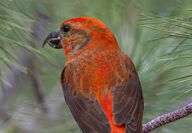
The Red Crossbill [Loxia curvirosta] is an erratic and nomadic bird that will flock to the tops of either deciduous or coniferous trees for a wealth of seeds. A highly variably colored species, the female is a yellowish golden, with the male exhibiting various shades of red. Crossbills have a unique bill where the tips of the bill overlap to enable them to open conifer cones and seeds. With this skill, in seasons of plentiful cone production they may breed year round. Red... Full story
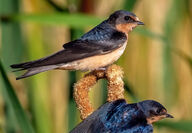
The Barn Swallow's [Hirundo rustica] distinctive long-forked tail makes it one of the easier North American swallows to identify. It has the most widespread natural distribution among birds in the world. When flying, the feathers are swept back and form a single long point behind the bird. A friend to farmers, these swallows are on an endless search for insects throughout the season. Barn Swallows build nests under eaves, bridges, cliffs, and maybe your patio. Nests are constr... Full story
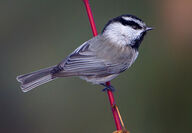
Often traveling in a group, they glean insects within pine, fir, and spruce trees in the forest or around our houses. The Mountain Chickadee [Poecile gambeli] will sing its merry, slightly hoarse fee-bee or chick-adee-adee-adee song. They prefer high-altitude forests and are found in the mountains from the Yukon down to Baja California and southern New Mexico. The Mountain Chickadee will choose a mate for life and is a cavity nester who molds its nest with fur and lays five... Full story

A familiar site on lakes, marshes, ponds, and rivers, the Mallard [Anas platyrhynchos], with its glossy green head and orange feet, is a stunning duck. Mallards are dabblers, feeding on invertebrates, fish, and insects. They molt twice a year and regrow their waterproof feathers. They are known for flying in a V formation, cruising at 55 mph, and alternating the front leaders to maintain the flock's stamina. The hen Mallard builds a mostly grass and twig nest, lined with... Full story
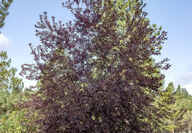
Bitter cherry, bird cherry, chokecherry, or bitter berry are all common names for Prunus virginiana. My neighbors have several in their yard that are of the Canada red variety of chokecherry. Deep burgundy-red leaves, prolific whitish blossoms, and dark red berries grace the spreading branches. It was a prized food source for Native Americans as the berries contain many disease fighting antioxidants, anthocyanins, and flavonoids which possess properties that fight allergies,... Full story
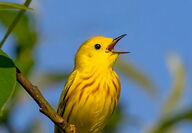
The brightly colored Yellow Warbler [Dendroica petechia] spends the winter in Central America, and will soon be migrating 2,000 to 4,000 miles to breed in shrubby streamside areas around Sisters. The migration route is very treacherous, as the Yellow Warbler flies over the Gulf of Mexico from Yucatan to Texas and Louisiana. Soon after arrival on their breeding grounds, the males begin to select their territories and defend them, singing their bright songs from perches around t... Full story
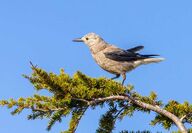
Clark’s Nutcracker (Nucifraga Columbiana) occupies an integral role in the regeneration and maintenance of high-elevation pine forests. They store pine seeds, plucked from cones by their strong and sharp beaks, in a pouch behind their tongue. Up to 90 seeds are stored within this pouch, which are then cached in the ground over a large area. In the fall up to 33,000 seeds will be stored in the ground and the Clark’s Nutcracker is able to remember where they cached the see... Full story
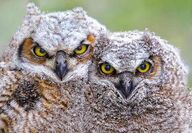
Our most common owl is the Great Horned Owl, [Bobo Virginianus]. A nocturnal hunter, they hunt silently, gliding over fields and woodlands in search of mostly small mammals. However Great Horned Owls (GHOs) will also prey on other owls, hawks, snakes, and young alligators. Over 250 prey species have been identified. They are native to a large geographic range that covers most of North America and extends south into Central and South America. Males hoot throughout the year,... Full story
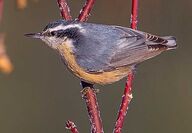
A full-time resident of our pine forests, the Red-breasted Nuthatch, [Sitta canadensis], can be found climbing up and down tree bark using their enlarged toe and short tail, gathering conifer seeds and various insects, including beetles, worms, ants, earwigs, and spiders. They are common visitors to black oil sunflower feeders and they will often cache foods between the bark of trees for later use. The female Nuthatch will most often choose the nest and prefers soft wood trees... Full story
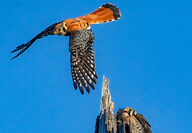
Our most common small falcon, the American Kestrel [Falco sparverius], is often seen on fence posts, tree snags, and telephone wires. This 8- to 12-inch tall bird is also known as the Sparrowhawk. They hover overhead and kite down to capture their prey. Nests are built in cavities in trees, rock walls and even buildings. The male will choose several nest sites and present them to the female and she makes the final decision. No nesting material is used except what is already... Full story